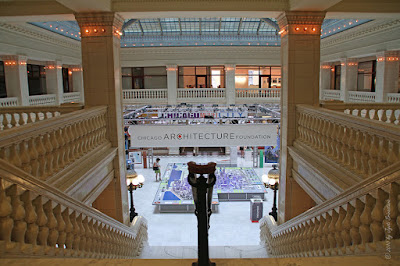

 The Exelon Tube..
The Exelon Tube.. A concrete tube, clad in corrugated stainless steel, that wraps the CTA elevated railroad ["L"] tracks to dampen the train noise.. The concrete and stainless steel tube encloses a 530-foot stretch of the L tracks... and it really dampens the sound of the trains over-head as students enjoy various campus activities below.
And beneath this Exelon Tube is the Campus Center.

Students playing in the Campus Center, as a Green Line train passes right above them, through the Exelon Tube..
The Exelon Tube and The McCormick Tribune Campus Center..Location: 33rd and State Streets, on Chicago's south side.
Designed by Pritzker Prize winning architect Rem Koolhaas, of the Office for Metropolitan Architecture [OMA], Rotterdam..
This is Koolhaas' first completed building in the United States..
Under the Exelon Tube, is the main building, a one-story, 110,000 square foot structure containing the program spaces (Welcome Center, dining, auditorium, meeting rooms, bookstore, cafe, post office, offices, convenience store, and campus radio station) under the tube. Movement through the main building is along diagonal paths located according to research analyzing the walking patterns of students across the site. Seeking to accommodate students, the paths intersect to create island spaces and nodes of activity for the students and faculty

As one enters the building, this is the view. Orange hues on the west side and green in the center..
 The Ramp-Seating..
The Ramp-Seating..As we enter, we see these steps and space.. This terrain is for student gathering. Notice the steps skillfull of steps and handicapped ramp at the same time. Apart for providing space for gathering, it leads to the center-court.
 Center Court..
Center Court..The ramp leads to a sunken two-story center court, with recreational and dining area.. This might have been a dingy basement..
 Hanging Garden..
Hanging Garden..Note the hanging garden lies above the center-court. It brings light and nature to the heart of the building.
 Broadband
Broadband..
A sunken area, with a continuous band of computer stations.. The 93-foot-long shelf is painted a bright red.
 Mies Wrap/ Orange Hallway..
Mies Wrap/ Orange Hallway.. A continuous orange wall on the west side of the building, that brightens the entire interior..And I love the color orange..
 Lobby..
Lobby.. Recreational Area..
Recreational Area..Just beneath the railway tracks, covered in the Exelon Tube..
The main federating element is the roof, a continuous concrete slab that shields the centre from the noise of the elevated railway while unifying the heterogeneity below.- Rem Koolhas..
 Welcome Center..
Welcome Center..
 Glass portrait of Mies van der Rohe..
Glass portrait of Mies van der Rohe..On the northwest side of the building, visitors enter through a 20-foot image of Mies’s face.. The master plan of the IIT campus, wasdesigned by Mies in 1941. It is one of the largest projects he conceived. The campus encompasses 20 of his buildings, the greatest concentration of Mies-designed buildings in the world.

The Map..





















































